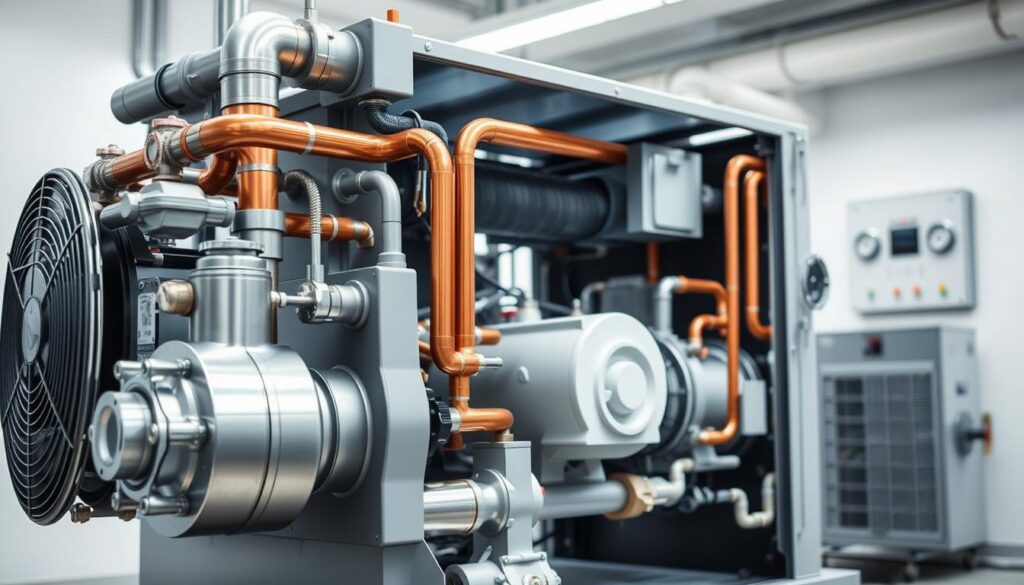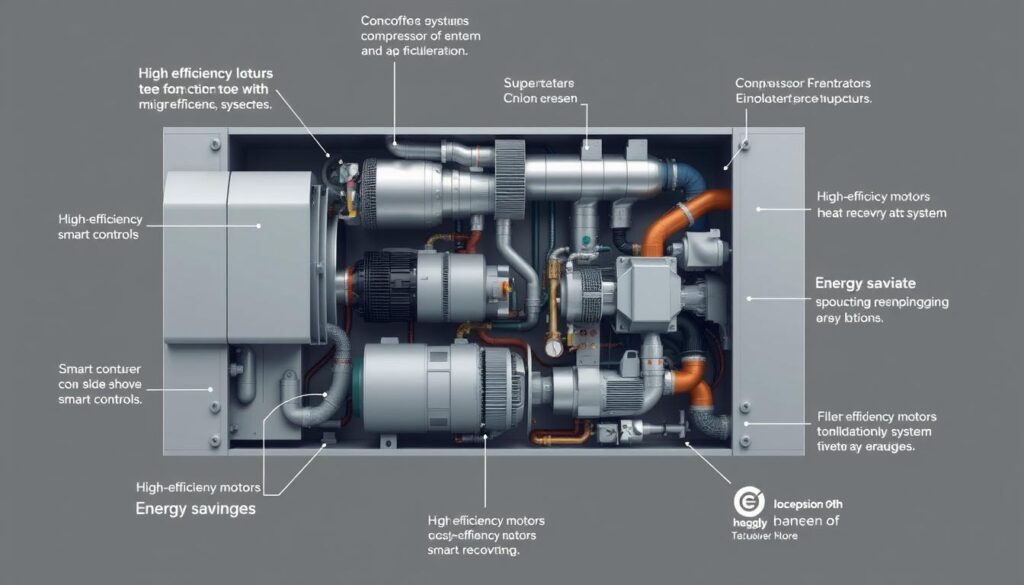Affiliate Disclosure
HVAC Guide Guys is a participant in the Amazon Services LLC Associates Program, an affiliate advertising program designed to provide a means for sites to earn advertising fees by advertising and linking to Amazon.
How HVAC Systems Work? Ever wondered how your home stays just right all year? HVAC systems are the quiet heroes of comfort, working hard to keep your space cozy in every season.

Knowing how HVAC systems work is key for homeowners wanting the best indoor climate. These systems do more than just control temperature. They handle air quality and humidity levels in homes, offices, and more.
HVAC means Heating, Ventilation, and Air Conditioning. It’s a complete system for managing indoor climate. In the U.S., about 87% of homes use central air conditioning for cooling.
Your HVAC system is more than a thermostat. It’s a complex system designed to make your indoor space perfect. With regular care, it can even cut your energy bills by up to 50%.
Key Takeaways
- HVAC systems manage temperature, humidity, and air quality
- Central air conditioning is the most common residential cooling solution
- Proper maintenance can reduce energy costs by up to 50%
- HVAC systems operate effectively across various environments
- Modern systems offer advanced energy efficiency features
Table of Contents
Understanding HVAC System Fundamentals
Your home’s comfort relies on a complex system of heating, cooling, and ventilation. HVAC systems are complex machines. They keep your indoor environment perfect all year round.
HVAC systems manage temperature, humidity, and air quality to make your home comfortable. They do more than just control temperature. They are advanced solutions for your home’s comfort.
What Is an HVAC System?
An HVAC system is a network of equipment. It works together to:
- Regulate indoor temperature
- Control humidity levels
- Circulate and purify air
- Maintain optimal indoor air quality
The Role of HVAC in Home Comfort
Your HVAC system is key to a comfortable home. It adjusts to outside temperatures. This keeps your home a cozy, consistent space.
“HVAC systems are the silent guardians of indoor comfort, working tirelessly to maintain the perfect environment.”
Primary Functions of HVAC Systems
Modern HVAC systems have several important roles:
- Temperature Regulation: Heating in winter, cooling in summer
- Air Circulation: Moving air through ducts or units
- Air Purification: Filtering out dust, allergens, and pollutants
- Humidity Control: Keeping moisture levels just right
Did you know? Over 50% of US home energy goes to heating and cooling. Regular upkeep can cut energy use by 5-30%. This makes HVAC systems good for the planet and your wallet.
Essential Components of an HVAC System
Knowing the main parts of an HVAC system is key to keeping your home comfy and energy-efficient. Your HVAC system is made up of many parts that work together. They control temperature, humidity, and air quality.
- Thermostat: The control center that manages temperature settings
- Furnace: Provides heating by warming air through a heat exchanger
- Air Conditioner: Removes heat and humidity from indoor air
- Heat Pump: Transfers heat between indoor and outdoor environments
- Air Handler: Circulates conditioned air throughout your home
Managing HVAC airflow depends on several key parts. These parts make sure air moves well:
| Component | Primary Function | Maintenance Frequency |
|---|---|---|
| Evaporator Coil | Dehumidifies and cools air | Annual inspection |
| Condenser Coil | Releases heat from refrigerant | Bi-annual cleaning |
| Air Ducts | Distribute conditioned air | Annual cleaning |
“70% of homeowners report satisfaction with their HVAC systems when indoor comfort is maintained” – HVAC Performance Survey
Every part of your HVAC system is important for your home’s comfort. Regular maintenance is essential for good performance and avoiding expensive fixes. Change your air filters every two months and get professional checks to keep your system in top shape.
Explore Our HVAC Shop
Looking for top-rated HVAC tools, parts, and accessories? Visit our shop and find the perfect solution for your needs.
Visit the ShopHow HVAC Systems Work
HVAC systems are complex machines that keep your home comfortable. They manage temperature and air quality with precision. Learning about HVAC systems shows the engineering that keeps your home cozy.
The hvac operating principles involve three key processes: cooling, heating, and air distribution. These functions work together to create the perfect indoor environment.
The Cooling Process
Your air conditioning system uses a cool refrigeration cycle. Warm indoor air meets the evaporator coil, where refrigerant absorbs heat and turns into gas. An outdoor fan then blows out this heat, cooling your home.
- Refrigerant absorbs indoor heat
- Liquid transforms to gas
- Heat is expelled outside
- Cool air circulates back into rooms
The Heating Process
Heating works differently depending on your system. Gas and electric furnaces warm air before it circulates. Heat pumps take warmth from outside air or ground, saving energy.
Air Distribution and Circulation
Ductwork is your HVAC system’s circulatory system. Blowers push conditioned air through ducts, ensuring even heating. Good duct design cuts down on air loss and boosts efficiency.
“Efficient HVAC systems can reduce energy consumption by up to 30% when compared to outdated units.”
Understanding HVAC systems shows the advanced technology that keeps your home comfortable all year.
Different Types of HVAC Systems and Their Applications
Choosing the right HVAC system is key for comfort and saving energy at home. The type you need depends on your home’s layout, the weather, and special needs.
Today, there are many HVAC systems for homes and businesses. Knowing about them helps you pick the best for your climate control.
- Split Systems: Most common for homes
- Has separate indoor and outdoor units
- Can be installed in many ways
- Accounts for about 35% of HVAC sales
- Ductless Mini-Split Systems: Great for cooling specific areas
- No need for ducts
- Can cut energy use by 30-40%
- Good for older homes or new additions
- Packaged Heating and Cooling Systems: All-in-one for easy setup
- Has everything in one unit
- Often used in commercial places
- Makes up about 12% of HVAC setups
“The right HVAC system can improve indoor air quality and reduce energy costs by up to 50%.” – HVAC Energy Efficiency Institute
Geothermal systems are a new way to save energy, cutting heating costs by up to 70%. They use the earth’s stable temperature for heating and cooling.
| HVAC System Type | Energy Efficiency | Typical Installation Cost |
|---|---|---|
| Split Systems | 15-20% savings | $3,000 – $5,000 |
| Ductless Mini-Split | 30-40% savings | $2,000 – $14,000 |
| Geothermal | Up to 70% savings | $10,000 – $25,000 |
When looking at HVAC systems, talk to a pro who can check your needs. They’ll consider your home’s size, the weather, and how much you want to save on energy.
Explore Our HVAC Shop
Looking for top-rated HVAC tools, parts, and accessories? Visit our shop and find the perfect solution for your needs.
Visit the ShopThe Heating Components: Furnaces and Heat Pumps
Knowing about HVAC heating and cooling systems is key to keeping your home cozy. These parts are essential for warmth during the cold months.
Gas and Electric Furnaces
Furnaces are the core of home heating. They make heat in two main ways:
- Gas furnaces burn natural gas or propane to warm up
- Electric furnaces use electricity to create heat
“Heat is not just about temperature, it’s about creating a comfortable living environment.”
Heat Pump Operation
Heat pumps are a new way to control home temperature. They can both heat and cool your home by moving heat from outside to inside.
| Heat Pump Type | Temperature Range | Efficiency |
|---|---|---|
| Air-Source Heat Pump | Above 0°F | High efficiency in mild climates |
| Ground-Source Heat Pump | Consistent year-round | Highest overall efficiency |
Hybrid Heating Systems
Hybrid systems mix furnace and heat pump strengths. They offer the best heating in all temperatures, saving energy and keeping you warm.
- Switches between heat pump and furnace based on outdoor temperature
- Reduces overall energy consumption
- Provides reliable heating in extreme cold
Understanding these components helps you choose the right heating and cooling for your home.
Air Conditioning and Cooling Technology
Air conditioning is key to modern home comfort. Your HVAC system’s cooling parts work together to remove heat. This makes your home comfortable. The science behind air conditioning is complex but interesting.

Knowing how your HVAC system works helps you understand cooling technology. Most homes in North America use central air conditioning. This method is used by about 90% of homes.
Types of Air Conditioning Systems
- Central Air Conditioners: Most common residential cooling solution
- Split-System Air Conditioners: Cover 70% of the U.S. market
- Ductless Mini-Split Systems: Flexible cooling for specific zones
- Packaged Air Conditioning: Prevalent in southern U.S. regions
The efficiency of air conditioning systems is measured by SEER (Seasonal Energy Efficiency Ratio). Modern units can have ratings over 20 SEER. This means they save a lot of energy.
| AC System Type | Market Share | Average Efficiency |
|---|---|---|
| Central Air | 90% | 14-20 SEER |
| Split-System | 70% | 15-22 SEER |
| Ductless Mini-Split | 10% | 16-24 SEER |
“Cool comfort begins with understanding how your air conditioning system works.” – HVAC Expert
Did you know that nearly 30% of residential HVAC energy use comes from air conditioning? Regular maintenance can improve system efficiency by 5-15%. This helps you save on energy costs and extend your system’s lifespan.
Modern cooling technologies keep getting better. They offer more efficient and eco-friendly ways to control your home’s temperature.
Explore Our HVAC Shop
Looking for top-rated HVAC tools, parts, and accessories? Visit our shop and find the perfect solution for your needs.
Visit the ShopVentilation and Air Quality Management
Your home’s air quality is key to your health and comfort. HVAC airflow management is more than just controlling temperature. It focuses on keeping your indoor air clean and safe. The ventilation system acts like your home’s lungs, filtering and circulating air to keep it fresh.
Effective hvac indoor air quality strategies use many advanced methods. These ensure the air you breathe is clean and healthy.
Air Filtration Systems
Modern HVAC systems use advanced filters to fight indoor air pollutants. Key features include:
- High-Efficiency Particle Air (HEPA) filters capturing over 99.97% of airborne particles
- Activated carbon filters targeting gaseous pollutants
- Multi-stage filtration removing dust, pollen, and microscopic contaminants
Humidity Control
Keeping humidity balanced is vital for indoor air quality. HVAC systems help manage moisture levels. This prevents:
- Mold and mildew growth
- Bacterial proliferation
- Respiratory discomfort
Indoor Air Quality Solutions
Advanced HVAC technologies offer complete air quality management:
| Technology | Function | Benefit |
|---|---|---|
| UV Germicidal Lights | Neutralize microorganisms | Kills bacteria and viruses |
| Smart Sensors | Monitor air quality | Automatic ventilation adjustment |
| Whole-House Filters | Comprehensive air purification | Consistent clean air distribution |
“Clean air is not a luxury, it’s a necessity for your health and well-being.” – HVAC Professionals
Regular maintenance is essential. It includes six-month system checks and filter replacements. This ensures your HVAC system keeps your home’s air quality at its best.
HVAC Energy Efficiency and Performance

Learning about HVAC energy efficiency can save you a lot of money and help the environment. HVAC systems use about 40% of all energy in commercial buildings. This makes it key for saving money and being green.
“Optimizing your HVAC system’s performance can reduce energy bills by up to 50%.”
Your HVAC system’s way of working affects how much energy it uses. Today’s systems use new tech to be more efficient:
- Variable-speed motors adjust to exact cooling and heating needs
- Smart thermostats change based on who’s home
- Multi-stage operation for exact temperature control
Here are some ways to boost efficiency:
- Keep your system in good shape
- Make sure it’s the right size
- Use advanced control systems
| Efficiency Strategy | Potential Energy Savings |
|---|---|
| Regular Maintenance | 10-20% |
| Ductwork Sealing | Up to 20% |
| Smart Thermostat Use | Up to 15% |
Choosing energy-saving HVAC tech cuts down on costs. It also lowers carbon emissions and helps the planet.
Explore Our HVAC Shop
Looking for top-rated HVAC tools, parts, and accessories? Visit our shop and find the perfect solution for your needs.
Visit the ShopSmart HVAC Technology and Controls
The world of HVAC has changed a lot. Now, smart technology makes heating and cooling systems smarter. They work better and use less energy.
Today’s smart HVAC systems give you more control and save energy. They use advanced sensors and smart controls. This lets you manage your home’s temperature easily.
Programmable Thermostats: The Brain of Smart HVAC
Programmable thermostats are a big step forward in saving energy. They can cut energy use by up to 30%. This means big savings for you.
- Automatic temperature adjustments
- Remote control via smartphone apps
- Learning capabilities that adapt to your preferences
- Detailed energy usage reports
Advanced Zone Control Systems
Zone control systems let you set different temperatures in different rooms. This makes your home more comfortable and saves energy. Smart zoning can improve energy efficiency by up to 40%.
Smart Home Integration
Now, HVAC systems work with your smart home. Geofencing technology changes the temperature when you’re away or back. This saves energy and keeps you comfortable.
“Smart HVAC technology isn’t just about convenience—it’s about creating intelligent, responsive home environments.” – HVAC Innovation Experts
Using these smart technologies, you can make your HVAC system better. It will fit your lifestyle and use less energy.
Maintenance and Care for HVAC Systems
Keeping your home comfortable and energy-efficient is key. Regular maintenance can make your HVAC system last longer and avoid expensive repairs.
“Preventive maintenance is the key to a long-lasting and efficient HVAC system”
Your HVAC system needs regular care to work its best. Homeowners can take steps to keep it running smoothly:
- Change air filters monthly
- Clean surrounding areas of outdoor units
- Schedule professional inspections twice annually
- Check for unusual noises or performance changes
Ignoring maintenance can cause big problems. Approximately 75% of HVAC systems fail due to improper maintenance. Regular checks can prevent these issues and save money.
| Maintenance Task | Frequency | Estimated Cost |
|---|---|---|
| Air Filter Replacement | Monthly | $10-$30 |
| Professional Tune-up | Biannually | $150-$300 |
| Duct Cleaning | Every 3-5 Years | $300-$700 |
Regular maintenance can save you up to 30% on energy bills. By being proactive, your HVAC system will run efficiently, keep your home comfortable, and avoid sudden failures.
Conclusion
Knowing how HVAC systems work is key to a comfy and efficient home. Your understanding of HVAC installation and sizing affects your energy use and comfort. HVAC systems use about 50% of household energy, making smart choices vital.
Getting expert advice is essential for choosing the right system. Many homeowners don’t realize the importance of proper HVAC sizing. About 23% of systems are installed wrong. Certified HVAC pros can help, saving up to 30% with Energy Star systems.
The future of home comfort is in smart HVAC tech. Zoned systems and Energy Management Systems can cut bills by 20%. Regular maintenance and smart upgrades boost your home’s comfort and energy efficiency.
Your HVAC journey continues. Stay updated, seek professional help, and choose the right system. It will enhance your comfort, air quality, and save money. Invest in your home’s comfort with knowledge and planning.

